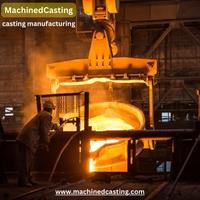Casting manufacturing is a crucial process in various industries, from automotive to aerospace, jewelry, and beyond. It involves shaping molten metal or other materials into a desired form by pouring it into a mold and allowing it to cool and solidify. This guide aims to provide a detailed overview of casting manufacturing processes, techniques, materials, and considerations for achieving optimal results.
Understanding Casting Processes: There are several casting processes, each suited for different applications and materials:
-
Sand Casting: This is one of the oldest and most versatile casting methods. It involves creating a mold from compacted sand and then pouring molten metal into the mold cavity. Sand casting is ideal for producing large parts with complex geometries.
-
Investment Casting: Also known as lost-wax casting, this process involves creating a wax pattern of the desired part, coating it with a ceramic shell, and then melting out the wax to leave a cavity. Molten metal is then poured into the cavity to produce the final part. Investment casting is suitable for producing intricate parts with high dimensional accuracy.
-
Die Casting: Die casting utilizes a reusable metal mold, or die, to produce parts with high precision and surface finish. Molten metal is injected into the die cavity under high pressure, allowing for rapid production of complex shapes. Die casting is commonly used in the automotive and electronics industries.
-
Continuous Casting: This process is used primarily for producing metal sheets, strips, and rods with a constant cross-section. Molten metal is poured into a water-cooled mold, where it solidifies and is continuously withdrawn as a solidified product.
Materials Used in Casting: The choice of material depends on factors such as the desired properties of the final part, its intended application, and cost considerations. Common casting materials include:
-
Ferrous Metals: Such as iron, steel, and stainless steel, are widely used in casting due to their strength, durability, and heat resistance.
-
Non-Ferrous Metals: Including aluminum, copper, and zinc, offer advantages such as lightweight, corrosion resistance, and good thermal conductivity.
-
Alloys: Many casting materials are alloys, combining different metals to achieve specific properties like increased strength, improved machinability, or enhanced corrosion resistance.
-
Ceramics and Plastics: In addition to metals, casting can also be used with ceramics and plastics to produce a wide range of parts for various applications.
Considerations for Successful Casting: To ensure successful casting manufacturing, consider the following factors:
-
Design for Manufacturability: Optimize the part design for the chosen casting process to minimize defects and achieve the desired properties.
-
Mold Design: Create molds with proper gating, risers, and venting to ensure uniform filling and solidification of the part.
-
Material Selection: Choose the appropriate casting material based on the part's requirements and the casting process being used.
-
Process Control: Monitor and control parameters such as temperature, pressure, and cooling rate to minimize defects and ensure consistent quality.
-
Post-Casting Operations: Plan for necessary finishing operations such as machining, heat treatment, and surface treatment to achieve the desired final properties and appearance.
Conclusion: casting manufacturing is a complex but essential process for producing a wide range of parts used in various industries. By understanding the different casting processes, materials, and considerations outlined in this guide, manufacturers can optimize their casting operations to achieve superior quality, efficiency, and cost-effectiveness in their production processes.


